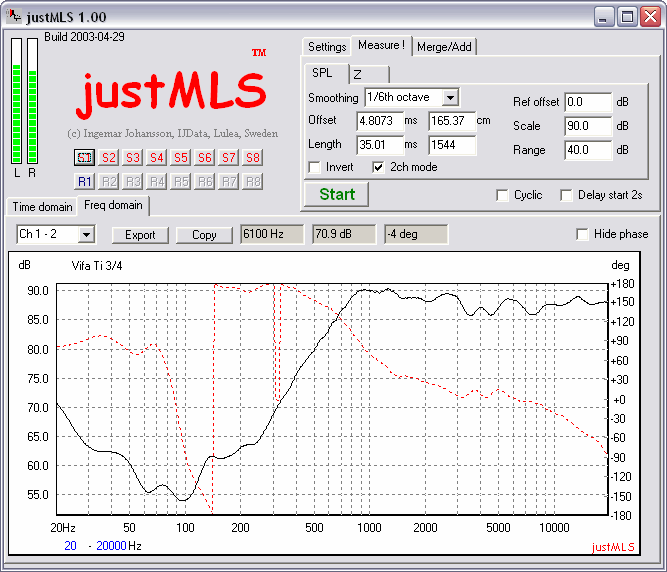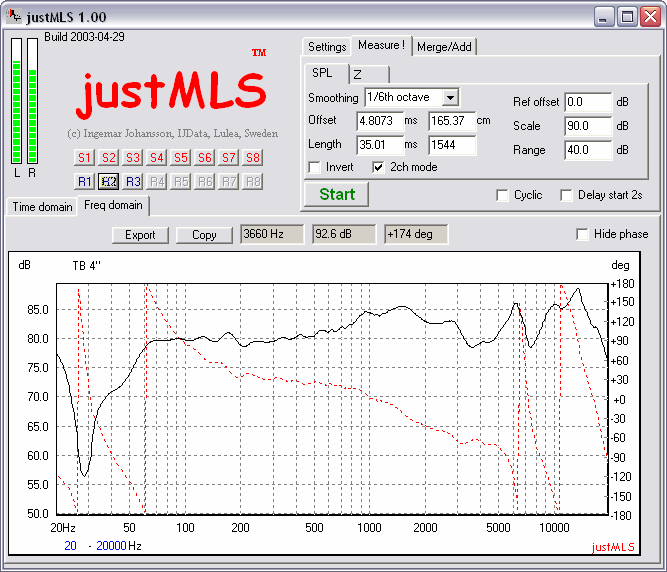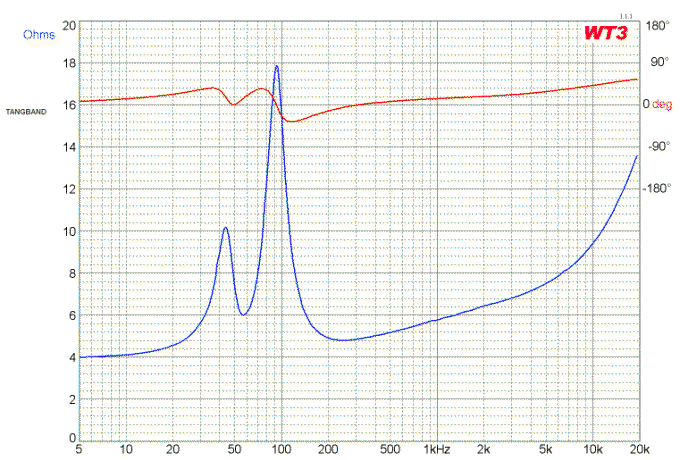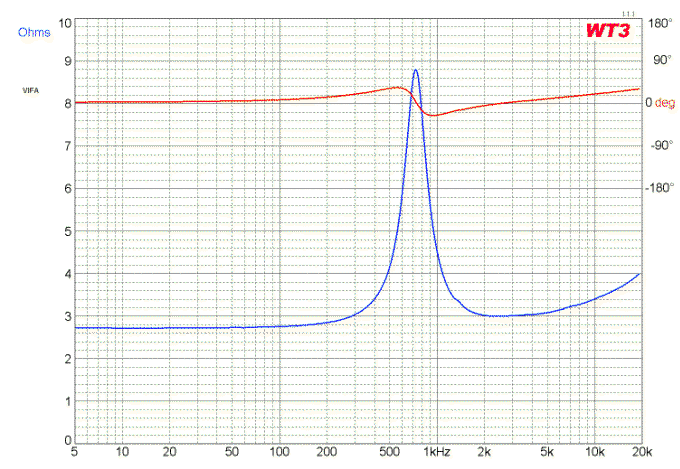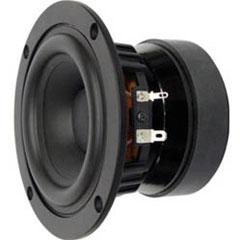| Last Update: 16 MAY 2010 | Petite Desktop/HT/Bookshelf Monitor | Lou's Home Page |
| High End, Full Range Sound in a Small Footprint | ||
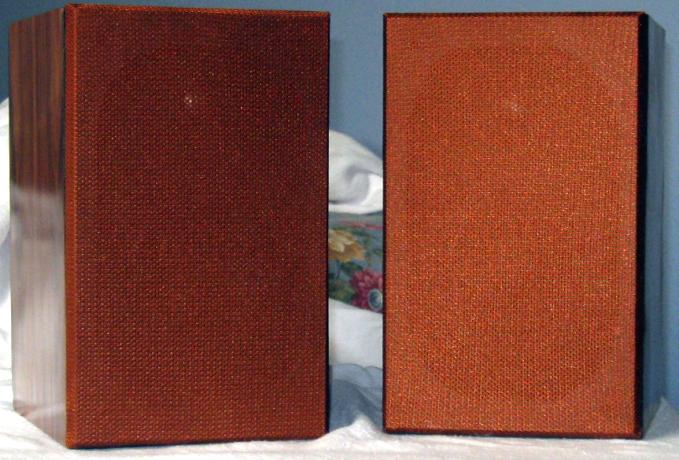 |
||
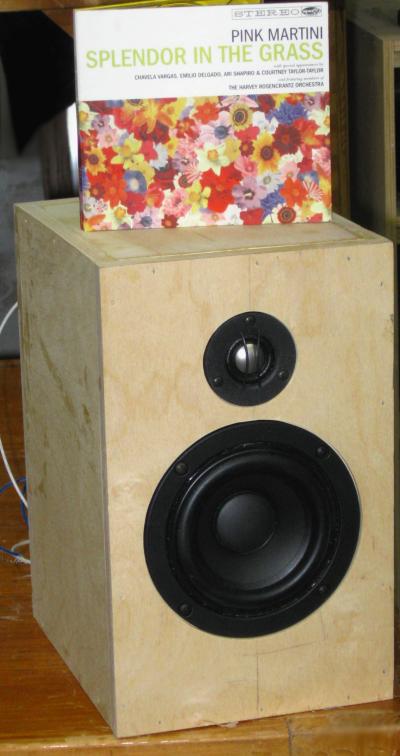 |
|
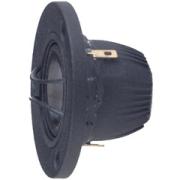 Vifa NE19VTT-04 3/4" Titanium Silk Surround Tweeter |
|
|
|
Background
I just returned from a vacation to the Left Coast. Spent an evening with my sister's friend in a beach front condo on the SoCal. The "living room" wasn't as big as my spare bedroom. The owner insisted he appreciated "quality sound". He just couldn't crank it up too much. He had a pretty nice "executive" setup that didn't sound half bad -- especially after a couple of cocktails. If he could afford nearly 7 figures for 900 square feet, I figured there might be others who want something small, but righteous sounding. So I set out to see what I could do with small boxes and somewhat upscale drivers --high quality at lower volumes.
I have far too many buyouts and, frankly, I'm tired of building "cheap" speakers. (I've run out of people to give/sell them to!) With the economy as it is, cheap seems to be the norm. I can certainly understand that. Thanks to Jeff Bagby's excellent freebie tools, DIY designs with economy drivers are proliferating like bunnies in the cabbage patch. But I think there are some intriguing new drivers out there.
I was very pleased and impressed with the build (and bass) quality of the 5" TangBand Underhung Woofer (TBUH) I used in a TL alignment in the TunDar and really liked the bass. So I invested an unexpected windfall in a pair of the 4" and the 6.5" TBUH versions as well. The Amethyst has been a pretty popular design based on my emails. Lot's more people are using their desktops for music, movies and TV viewing. So I set out to design another small monitor with some upscale drivers. Suitable for desktop, small apartments, or home theater satellites.
Design Considerations
While I think the small Dayton neos are a great value, I wanted to try something different. The Vifa NE19 series looked like a nice alternative. I looked over the various models, and decided the titianium had the most "way cool" factor and a low enough Fs to give me a bit of flexibilty on crossing over.
With a tweeter in hand, I checked quite a few box alignments and shapes before settling on this one. While the Xmax numbers on all of these TBUH look impressive, I found the Tundars were pretty easy to bottom out. I slightly undersized the box and worked the dimensions to accomodate the longer port lengths necessary to get a bit of bottom end out of the Piccolata. The result is a petite box. I used 1/2" baltic birch for the box, going to 3/4" for the baffle. (Even the 4" TBUH is heavy!) Ports are in the rear, flanking the tweeter.
When I measured the drivers, I expected the TangBand factory curves would be optimistic. They weren't. I'm surprised they called this a 4 ohm driver, it's impedance is more in step with a 6 ohm or 8 ohm driver. I got nearly identical results from LspCad and the WT3. (Everything measured in the box) . The TB has a broad gentle peak centered about 1500 Hz. This was easily tamed with small cap over coil notch filter.
I tried using both iron core & air core coils on the woofer. The iron core version was happier crossing about 2600 Hz the air core at 3000. I decided I like the air core version a bit better, and there really isn't much difference in price. So I've shown that below. Otherwise, the crossover is pretty straight forward. The spilit padding resistors help with phase alignment.
Update Feb 2011 DIY AZ
I think the Piccolatas got as much air time as any design there. I think the most apt reaction was amazement. Several people asked how the heck they could produce such authoritative bass from such a small box -- and still handle the mids so well? I certainly got more comments and questions on these than any other design I brought.
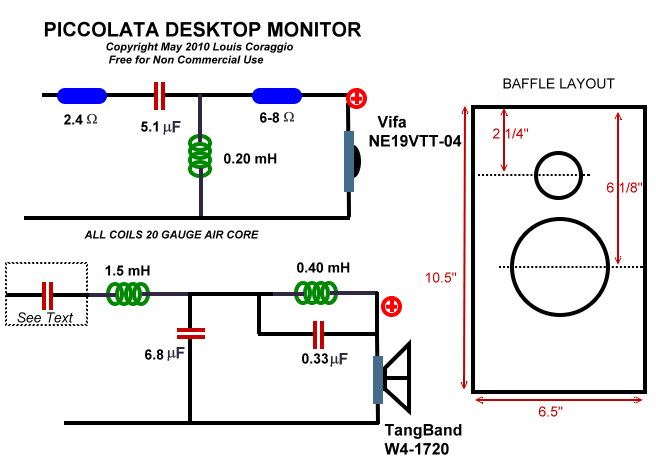
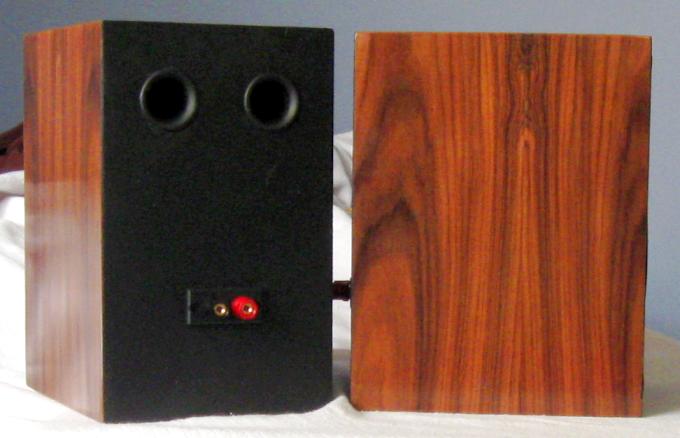
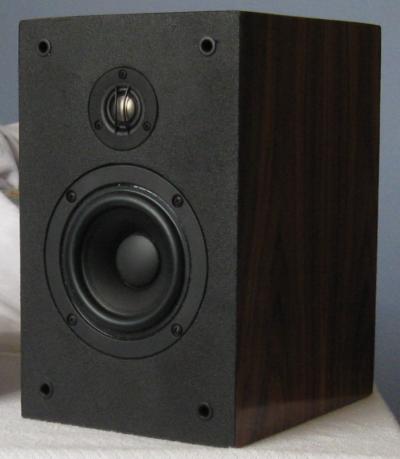
Finishing and Assembly
Some projects go together without a hitch. Most don't. I found a piece of NBL Santos Rosewood that I'd kept since I did my ACI Jaguars 10 years ago. I had just enough to wrap the sides top & bottom with about 1/8" to spare. I sealed with dewaxed shellac and brought out my detail gun to shoot a few quick coats of waterborn acrilyc. The first box was nearly perfect. The second was cursed. (Some chunks of old finish clogged my gun) then some big runs and finally a swarm of knats decided to try to eat the clear coat. So I sanded most of the finish off (mmm bug guts!) and sprayed it again. Put it on too thick, and it checked when dry. Filled the cracks with a paint brush, sanded again and just wiped on a skim coat (20% diluted with water). Not perfect, but it will do. (You're never too experienced to be humbled) A couple quick coats of Duratex for the front and back.
I lined the box with 1/2" Sonic Barrier and a fistful of dacron batting. Since the port tubes PE # 260-470 needed to be 5" long, I used 6 of them. Two were cut up and the extra inch added to the remaining 4 with hot melt and electricians tape. No extra bracing was used.
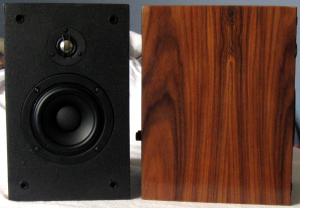
Listening, Tweaking & Use
I bought a new Dayton measurement microphone and calibrated it with my Edirol sound card. The modeled response now looks like final measurements with minimal tweaking -- so I'm fairly confident these modeled response curves are very close to as built.
Once I fired these up, I understood where the driver $$$ go. Very clear clean mids, vocals, and percussion. The TB is clearly a well controlled driver. Definitely a paper sound, forgiving and mellow without giving up any detail and nuance. I think this Vifa tweeter is a real winner. Exquisite percussion, nice air and sparkle with no hint of grit. Forgiving of poorly mastered recordings. It's very petite, and could probably go down to 2000 with steep crossover slopes. (Be aware it's metric sized so don't cut your baffle holes until you have them in hand) In this design, the final padding resistor is pretty flexible. I liked 7 ohms with my gear, but 6 ohms was very listenable. For nearfield use (computer) I might drop it to an 8 ohm. Even at 7 they may be a bit brighter than my usual voicing, but the Vifa is very forgiving.
Now the good news/bad news. The bass is tight, well controlled, with very clear definition. These will definitely hit the 50's and move a lot of air especially for a 4" driver. They just won't do it very loud. (My sims suggest about 95 db at 1 meter) Much like the Tundars, within its limits, the Piccolata is a very satisfying full range speaker. You won't be able to push much more than 25-30 watts before the driver reaches excursion limits. (You will definitely know when that happens!) If one has the budget and you need that kind of thump in a small box then moving up to the ScanSpeak 5" Revelator would be a logical step. If you use these in a small room or for nearfield, I doubt you will find them lacking volume or bottom end. Ditto for home theater with bass management. If you can roll these off at 80 Hz or higher, I don't see much of a problem. For the bedroom, they'll handle your Barry White CD's just fine.
I set them up as the mains in my man-cave system. (No protective cap) On their own, carrying all the bass, they are really capable of very satisfying full range volumes before bottoming out. Rolling them off at 80 Hz, with the sub, I could pump the whole load from the HK AV154 into them without a whimper. Clean until the amp started clipping.
The Piccolata is a substantial step up in overall quality, clarity and bass from the Amethyst in about the same size footprint. For apartments, dorm dwellers, computer desktops, or a modest sized home theater, I think they'd be a great choice and worth the extra "mid fi" cost. As of this writing about $100 each, not outrageous for this quality level.
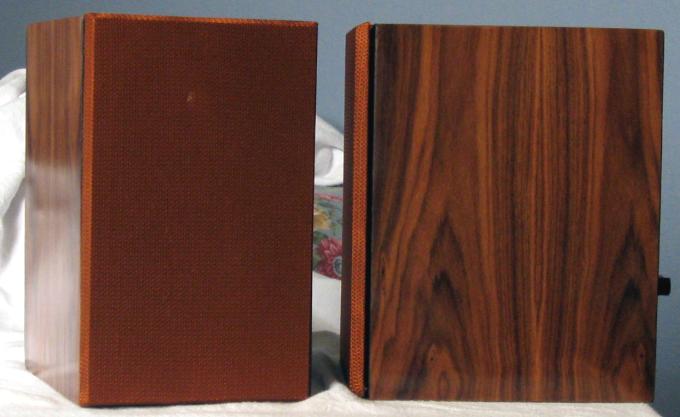
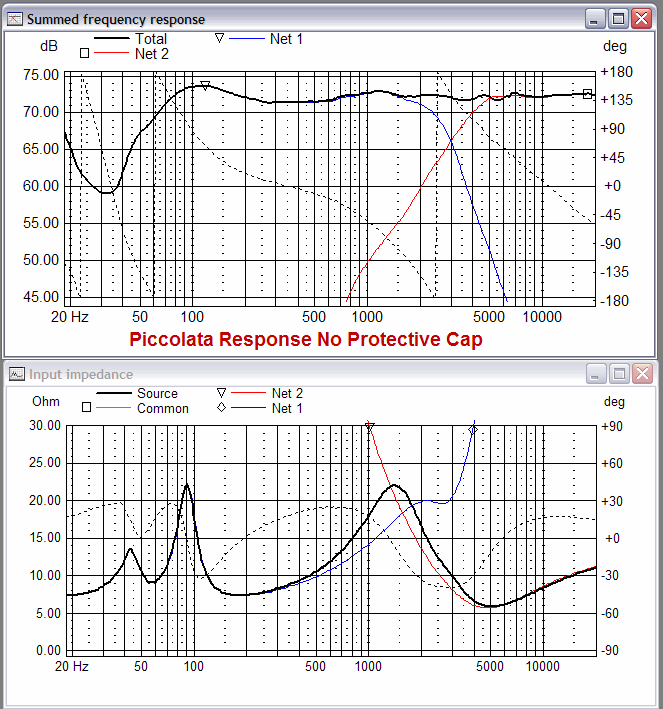
If you want a few more dB and are willing to sacrifice a bit of the bottom end, you can use a protective cap ahead of the woofer circuit. I found 250-300 uF did a nice job of giving the Piccolata a bit more oomph. The cap adds a bit of a knee at about 80-90 Hz so you get the first harmonic boost on those low notes. It won't stop you from blowing the driver with death metal turned up to 11, but it will get you another 2-4 db of overall volume.
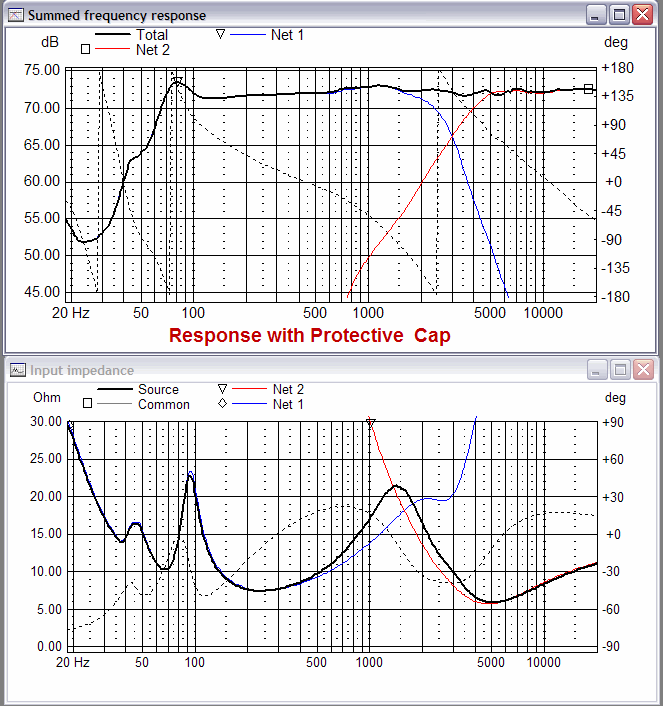
Note: these are in Box, Ground Plane Measurements
